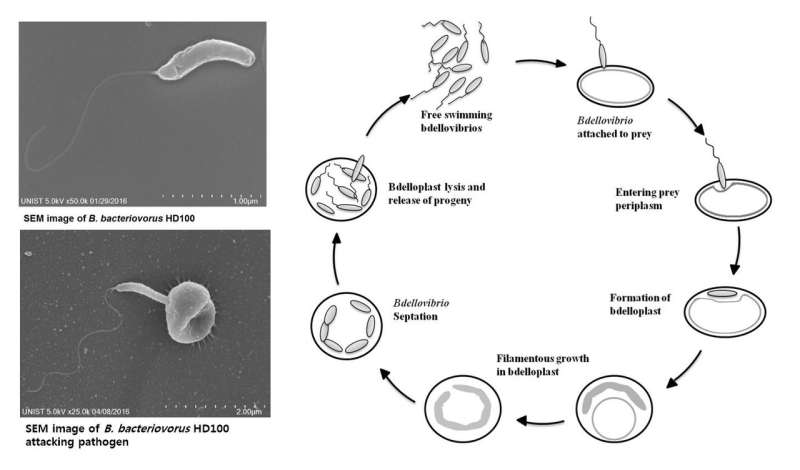Researchers reveal how one bacterium inhibits predators with poison

Infections caused by gram-negative bacteria such as salmonella, pneumococcus, and cholera are a major problem for patients with compromised immune systems, as well as for premature babies. Bdellovibrio and like organisms (BALOs) are bacterial predators that attack and feed on other gram-negative bacteria without harming humans. Therefore, the use of predatory bacteria has been suggested as an alternative approach to tackle a range of drug-resistant, gram-negative bacterial infections that can develop in hospitalized patients. However, recent studies have revealed that some gram-negative bacteria appear to be resistant to BALOs.
A research team affiliated with UNIST has reported that the bacterium Chromobacterium piscinae produces cyanide, an inhibitory molecule, to defend itself in the battle against Bdellovibrio bacteriovorus HD100. This breakthrough has been led by Professor Robert J. Mitchell and his team in the School of Life Sciences at UNIST.
In the study, the research team found that the amount of cyanide produced by C. piscinae was sufficient enough to inhibit predation, but not overtly toxic toward B. bacteriovorus HD100. Their results also showed that C. piscinae produced the protective cyanide when provided nutrients in the form of dilute nutrient broth (DNB). Through a series of experiments, the research team also identified that C. piscinae is preyed upon by B. bacteriovorus HD100 when provided in HEPES buffer, but that it was resistant when the tests were performed in DNB.
"Our study suggests microbes may have means for resisting predation that only show up in certain environments," says Wonsik Mun in the School of Life Sciences, the first author of the study. "This study also suggests caution in defining bacterial strains that are susceptible to predation and those that are resistant, as secondary metabolites clearly can play a role."
To test whether cyanide alone was responsible or whether some other compound also acted as an inhibitor, the research team also performed additional experiments, purging and treatment of the supernatant with vitamin B12a. Their results confirmed that cyanide is the main, if not sole, inhibitor responsible. Further experiments also showed that vitamin B12a has detoxifying properties that help with the activation of B. bacteriovorus HD100. In this way, B. bacteriovorus HD100 can avoid these defensive mechanisms and deal with pathogens.
"Studying such mechanisms may lead scientists to better understand how some pathogenic bacteria protect themselves against antibiotics," says Professor Mitchell. "To understand how germs may resist treatment, we need to look at the actual conditions in the host."
The research team now plans to look at how other predatory bacteria respond to cyanide, as well as other factors that can potentially inhibit or negatively impact predatory activity in microbes.
More information: Wonsik Mun et al, Cyanide Production by Chromobacterium piscinae Shields It from Bdellovibrio bacteriovorus HD100 Predation, mBio (2018). DOI: 10.1128/mBio.01370-17
Journal information: mBio



















